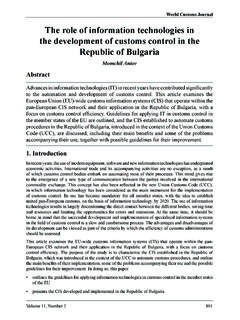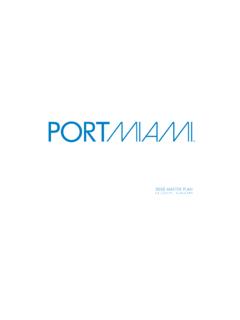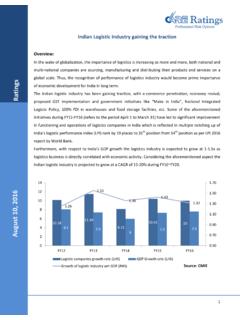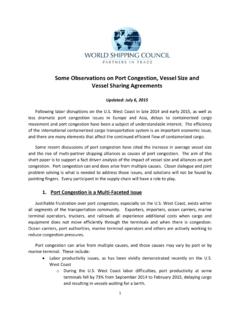Transcription of A new approach to e-commerce customs control in China ...
1 World customs Journal A new approach to e-commerce customs control in China : integrated supply chain a practical application towards large-scale data pipeline implementation Rong Hu, Yao-Hua Tan and Frank Heijmann1. Abstract Developments in e-commerce are presenting new challenges in customs control and China 's customs agency is developing a new approach to how it addresses these challenges. China customs has adopted an integrated supply chain approach to secure international trade lanes and to facilitate legitimate trade. We present a case study analysis of an integrated supply chain company that integrates the transaction, declaration, logistics and financial services of e-commerce customers on its platform, and we show how this integration can also be used by China customs to more effectively manage supply chain risks. We show how this new approach benefits traders, customs and government. We also analyse this case study in the context of the World customs Organization's (WCO) SAFE Framework.
2 1. Introduction As e-commerce continues to grow and develop, it is expected that China customs will be faced with specific e-commerce challenges. In this paper we present solutions to five of these challenges. The first challenge for China customs is that they do not have the resources to adequately control the increasing number of small and medium-sized enterprises (SMEs) that are without authorised economic operator' (AEO) status. Ten years ago there were approximately 100,000 companies in China that were either importing into or exporting from China . Most of these companies were large and more likely to be equipped to deal with the many administrative complexities associated with border clearance procedures and logistics. Now, however, there are an estimated one million traders in China , with most of these being SMEs. The anticipated number of traders over the next three to five years is five With the boom in cross-border electronic commerce, for example in Europe and the United States (US), it is clear that more and more SMEs will be involved in the international trade of multiple commodity categories.
3 Volume 10, Number 2 65. International Network of customs Universities Table 1: China general goods import and export figure in USD per company categories Source: (Year 2015 data not available). The second challenge is that these new companies (particularly SMEs) lack knowledge and professional expertise about customs regulations and procedures such as those related to the Harmonised System (HS), valuation, origin, and quarantine and therefore have a low level of customs compliance. It is quite common that shipments are delayed at the border due to non-compliance, which results in extra supply-chain costs and lead-time for the traders. Also, SMEs generally have low credit ratings and find it more difficult to get loans from banks, and experience delays in receiving their export tax refunds from China 's taxation and customs authorities. The third challenge is that there has been a considerable increase in the number of SMEs that falsely claim tax refunds on the export of non-existent goods (State Administration of Taxation 2015, ).
4 To accelerate the development of exports from China , its taxation authority organised an accelerated release of tax refunds for exported goods. In 2009, although the export volume from China decreased by 16 per cent, the export tax refund increased by 11 per cent. In 2011, China 's export volume increased by only 20 per cent, while the export tax refund increased by 26 per cent, which indicates that the extent of fraudulent export tax refund claims may be considerable (Kong 2014). Between 2011 and 2013, the State Administration of Taxation retrieved about billion in tax from fraud, and in the first six months of 2014 retrieved billion3 Similar cases of tax fraud have also been reported in Thailand (Jinakul & Jinathongpradit 2000), while an investigation in the Netherlands found that about 44 per cent of all value-added tax (VAT) fraud involved false tax claims based on forged invoices for non-existent or exaggerated purchases (Keen 2007).
5 In the United Kingdom (UK) VAT revenue losses through tax evasion jumped sharply in 2005 2006, reaching billion, or per cent of potential VAT revenues. Her Majesty's Revenue and customs (HMRC) estimated that missing trader and carousel fraud accounted for less than a quarter of these losses (Smith 2007, pp. 167 77). One case in the UK involved a complex GBP176 million VAT scam relating to the fake sale of four million phones, with millions of pounds in VAT payments being claimed through ghost companies (Garside 2012). The fourth challenge is that customs controls rely on the data contained in import and export declarations, but these declarations often contain inaccurate information about the cargo. Although all parties in international supply chains (such as traders, carriers, brokers, terminal operators and shipping agencies), are obliged by law to provide accurate data and declare all types of information related to goods, carriers, 66 Volume 10, Number 2.
6 World customs Journal brokers and agents do not always know what is in a container and they often use the term, said to contain' (STC) in the declarations to protect themselves against liability in case of theft or damage to the goods. For example, if a weapon of mass destruction was shipped by container through an international supply chain, it is estimated that it would cost the supply chain approximately trillion (Eggers 2004, p. 4). It is also observed that information management (in particular the sharing of cargo data by parties in a supply chain), and partner relationship management have significant positive effects on container safety performance (Yang 2013). The fifth challenge is fragmentation of supply chain information (see Figure 1). customs does not receive all the supply chain information as, for example, the logistics information, such as the vessel or aircraft manifest, is owned by the carrier; the trade transaction information is owned by the buyer (consignee).
7 And the seller (consignor); while the payment information is owned by the banks. In order to obtain all the relevant information across the whole supply chain, customs needs to invest resources to collect the fragmented data from the different parties in the supply chain, and then analyse it. Figure 1: Fragmentation of supply chain information Volume 10, Number 2 67. International Network of customs Universities 2. A solution for these challenges Stakeholders in the supply chain and the inspection authorities, such as customs , have realised that reducing the burden on business and helping stakeholders with their statutory obligations (such as providing the required customs information and complying with increasingly complex regulatory demands), has become a cornerstone of cross-border trading (Hesketh 2009, 2010; Tan et al. 2011). One way to facilitate this is to adopt the concept of a data pipeline' since such data-sharing infrastructure leads to the availability of better quality data in the supply chain (Klievink et al.)
8 2012). The data pipeline is a concept that forms the basis of a data information interchange platform, but it is still in an experimental phase, and more time is needed to develop certain aspects, such as standards, authorisations, financing structures and data sensitivity (Klievink et al. 2014). If we can find new solutions to combine the data pipeline concept with additional functions and possibilities for e-commerce customs control , it should prove to be more useful for the World customs Organization (WCO) and its members. Principles of a new approach A proposed new approach is underpinned by four principles, which are outlined below. Principle 1: Shared responsibility on risk control e-commerce control should not be the sole responsibility of customs ; enterprises should also be involved. The WCO SAFE Framework of Standards to Secure and Facilitate Global Trade (SAFE Framework). states that the cooperation between customs and economic operators is one of its main pillars, which means that firms should also be able and willing to share the liability and management of risk with customs .
9 As more inspection leads to congestion and low efficiency, incentives should be developed that encourage firms to improve security upstream in the supply chain (Bakshi & Gans 2010). At the same time, a public-private partnership (PPP) attitude is recommended (Hintsa 2010). Principle 2: Supply chain information integration Supply chain information should be integrated, so that customs has easy access to all relevant supply chain information, rather than having to collect different information from different sources, which is the current situation (Van Stijn 2011). For example, duty collection is an important task for customs , and it is easy for traders to falsify invoices, which impacts the calculation. Also, regular variations in the price of goods make it difficult for customs to determine the correct value. When customs suspects that the declared value is not accurate it needs to verify the authenticity of valuations, which may take at least 20.
10 Days (European Commission, Taxation and customs Union ). In this situation, exporters incur extra costs and their supply chain is delayed due to declaration suspension. However, with the availability of integrated supply chain information, customs could more easily ascertain the true transaction information, such as price, insurance and freight costs, which would then avoid delays. Principle 3: Earlier risk control Implementing risk control measures earlier in the supply chain will help customs identify compliant traders. The earlier customs is involved, or obtains the data from the supply chain, the more time customs has to conduct a risk analysis. The US rolled out the container Security Initiative (CSI) and Automated Manifest System (AMS) in 2002, and the European Union (EU) started using the advanced entry summary declaration (ENS) for security analysis in However, this ENS data is only provided at the container -loading points in the ports, while the supply chain starting points occur earlier than loading at the container terminals.








